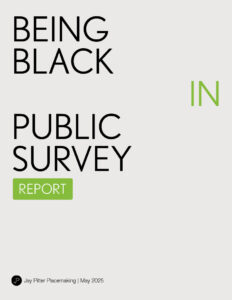BEING BLACK IN PUBLIC Survey Report
HOME > INSIGHTS ON TORONTO > RESEARCH AND REPORTS ON TORONTO > BEING BLACK IN PUBLIC SURVEY REPORT
BEING BLACK IN PUBLIC Survey Report
As it turns out, like everyone else, Black people want to freely belly laugh in public.
The BEING BLACK IN PUBLIC SURVEY report marks the fifth anniversary since George Flloyd was murdered in a bike lane. This initiative, led by Jay Pitter Placemaking, in partnership with the Faculty of Environmental and Urban Change at York University, and administered by the Institute for Social Research, offers compelling insight into Black people's public space experiences.
This work is one of many initiatives that Jay Pitter Placemaking’s award-winning, bi-national practice has led to ensure that public spaces foster safety, belonging and joy for people of all identities. Specifically, the report delivers on a practice promise that was made during the civil rights uprising that took place after the Floyd tragedy to ensure that productive steps, focused on public spaces, were taken after the corners of protest placards had worn out.
Unlike similar surveys, the BEING BLACK IN PUBLIC SURVEY did not strictly focus on police violence and harassment; it included other topics such as mental wellness, access to opportunities, and enhancements to the built environment. There are seven findings amplified by compelling survey respondent voices sharing stories and insights related to social attitudes, public spaces, design, and residual historical impacts.
In keeping with an asset-based approach, the findings are positively framed, outlining Black people’s public space aspirations, desires and priorities versus problem statements. This is in no way an erasure or sanitation of the data—every single section contains both positive and challenging survey responses.
The BEING BLACK IN PUBLIC SURVEY Report shares survey respondent voices from across 100 Canadian and U.S. cities who contributed over 18,000 data points through ranked and open-ended questions.
Here are a few highlights:
- A surprising, but common, through-line in the survey results was Black people’s desire to freely laugh in public spaces without fear of unwelcome staring, commentary or disciplinary action from others. For example, survey respondents referenced laughter in positive experiences of public joy, but also in negative experiences of being restricted or policed in public spaces. This finding shows how disturbing historical events can echo far into the future: apparently, during slavery, and, by some accounts, extending post-emancipation to the Jim Crow-era segregated South, Black people muffled their laughter in public in a “laughing barrel” to avoid harm.
- Black people feeling uncomfortable or dealing with outright hostility in public spaces was also a big theme. Alarmingly, 37% of respondents said they had missed out on an economic or educational opportunity due to discomfort (e.g., not feeling welcome in mainstream spaces, discomfort taking transit at night). For example, one respondent said, “Bruh, I skipped university till my late 30s I didn’t apply to jobs for so so so long.”
- Black people's responses were mixed when asked if public spaces enhanced or harmed their mental health. While 54% of respondents indicated spending time in public spaces had a positive effect, this was often qualified with commentary about how they had to practice hyper-vigilance in public spaces, constantly scanning their surroundings and maintaining awareness of potential risks.
- Black people voiced a strong desire to bring their authentic selves to public spaces through self-expression such as clothing, hairstyles, and choppin' it up with friends. However, they reported often moderating their behaviour or dress. Notably, the number one way Black people increased their sense of safety and belonging in public spaces was to behave extra respectably to counter anti-Black stereotypes.
Download and share the BEING BLACK IN PUBLIC SURVEY report.
*Download Appendix A, which contains unprecedented pre-research statistics and citations.
Funding partners for this report include Toronto Foundation and United Way Greater Toronto


